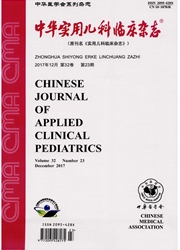

 中文摘要:
中文摘要:
胆汁淤积症的定义为血清总胆红素≤5 mg/dL(85.5 μmol/L)时,结合胆红素〉1 mg/dL(17.1 μmol/L);或总胆红素〉5 mg/dL(85.5 μmol/L)时,结合胆红素占总胆红素的比例〉20%。随着基因组学和分子遗传学理论技术的发展、成熟和临床应用,近年来遗传性胆汁淤积症的诊断治疗引起儿科界关注。此类疾病致病基因繁多,临床表现特异性不强,病因诊断依赖遗传学分析,治疗难度大,预后差别悬殊,往往给患儿及其家庭造成巨大痛苦和负担。现以希特林缺陷病、线粒体DNA耗竭综合征、微绒毛包涵体病和钠牛磺胆酸共转运多肽缺陷病为例,综述其诊断、治疗新进展,希望能够作为引玉之砖,为遗传性胆汁淤积症的诊治研究提供参考。
 英文摘要:
英文摘要:
Cholestasis is defined as a conjugated bilirubin level 〉1 mg/dL(17.1 μmol/L) if total serum bilirubin is ≤5 mg/dL(85.5 μmol/L), or conjugated bilirubin fraction 〉20% of total bilirubin when the total bilirubin is 〉5 mg/dL(85.5 μmol/L). In the recent years, the diagnosis and management of genetic cholestasis have caused considerable attention in the pediatric world, in pace with the development, maturation, and clinical application of the theories and techniques in genomics as well as molecular genetics.With a diversity of causative genes, genetic cholestasis usually demonstrates nonpathognomonic clinical manifestations.The etiology diagnosis such a disease relies on genetic tests, the treatment is often difficult, and the prognosis varies disparately, usually causing tremendous pain and burden on the affected patient and the family as well.Taking citrin deficiency, mitochondrial DNA depletion syndrome, microvi-llus inclusion disease and sodium taurocholate cotransporting polypeptide deficiency as samples, the recent advances in the diagnosis and treatment of genetic cholestasis are addressed.
 同期刊论文项目
同期刊论文项目
 同项目期刊论文
同项目期刊论文
 Etiological Analysis of Neurodevelopmental Disabilities: Single-Center Eight-Year Clinical Experienc
Etiological Analysis of Neurodevelopmental Disabilities: Single-Center Eight-Year Clinical Experienc SLC25A13 gene analysis in citrin deficiency: sixteen novel mutations in East Asian patients, and the
SLC25A13 gene analysis in citrin deficiency: sixteen novel mutations in East Asian patients, and the 期刊信息
期刊信息
